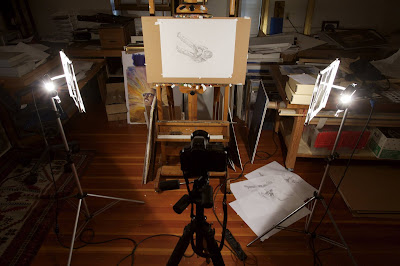


Some info on the tricky business of photopraphing artwork, from a recent workshop at CCA:
EQUIPMENT
Camera:
Manual control slr, (film or digital- although the thrust of this talk is digital, these principles can be applied to film)
Ideal features in a DSLR camera: white balance control, manual focus, manual control of aperture and shutter. Good to have: mirror lock up, depth of field preview, self timer or cable /remote release, RAW file support. Ideally no multiplier 1:6 is typical. Cameras with full-frame sensors are expensive but becoming more common:
Point and shoot cameras are useful for street photography and family gatherings but don’t work well for shooting artwork, because of parallax and lack of manual control.
Good cameras: Canon eos 30D, eos 40D, eos50D, eos 5d, eos5dmk2. (I use a 7 year old Canon EOS d60, a relatively primitive DSLR which works quite well.)
Corresponding Nikons are also good. D90 may be exceptional value . Buy what is comfortable for you.
Lens: 50-60 mm prime macro lens is ideal on SLR camera. Zoom or wide angle produces barrel distortion..
Polarizing filter for lens. Critical.
Support: 2 light stands. Make your own w/ Pvc pipe/ superclamps?
Tripod: Star-D is good and cheap. Used tripods are easy to find.
Lighting :
3200k photoflood lamps, homemade from ceramic socket and home depot bells, or lowel- tota/omni – lights no dimmers. 500 watts. Check for color changes.
Super clamps- let you clamp things to other things.
If there is any glare or shine on your work, you need polarizing filters for lights and lens
10x12 polaroid filters for lighting are essential. Polarizing filters remove light polarized at 90° to the filter's polarization axis.
Filter holders for lowel lights or other clamps- home depot clamps/ hold filters 6-8 inches from light. Many available from bhphotovideo.com.
OTHER
Kodak color bars, grey card
Measuring tape. Level may be useful. Duct tape, white tape.
Software: Photoshop, Aperture (or iphoto or lightroom)
Backup drives,
power strip w/ switch.
Shooting
Aperture: f8 , balance speed and depth of field
Artificial light: generally if possible, use artificial light because you can have more consistent results.
Digital: set ASA at 400 ok but test for noise, Film: asa 64 tungsten ektachrome
Digital camera white balance: tungsten (light bulb icon)
Place camera level w art at horizontal. Measure height of lens center and art center w tape.
Make sure art is level, square and flat. Very important. Devise way to hold art flat.
Place lights each at 45 degree angle to art, with polarizers with axis parallel to the floor. Check illumination by placing shadow at center of art, should be equal shadows l/r. Get even illumination, no hot spots or shadows.
Tape color bars to edge of art in live area.
Set ASA (digital) to no more than 400.
Set file type to RAW.
Set light to tungsten.
Square up camera to art, try to get everything clean, in focus. Focus with polarizer off.
Turn on pola on lens, check focus.
Set camera for f8, take reading off gray card, adjust for EV of cray card. Recheck focus, Lock up mirror, put on timer release, shoot and bracket 1/2 stop each way. Turn off lights- polarizers can burn.
Review results, adjust exposure as necessary. Use post-its on art to note test conditions.
Unplug everything when your done…fire hazard.
Do the same with film, but use tungsten ektachrome.
Resources:
http://www.metacafe.com/watch/1566782/making_homemade_light_stands_for_under_10/
clamp light
http://www.bhphotovideo.com/bnh/controller/home?O=1366&A=details&Q=&sku=262758&is=REG&addedTroughType=categoryNavigation#
bhphotovideo.com is best online resource for equipment.
-Robert Hunt
